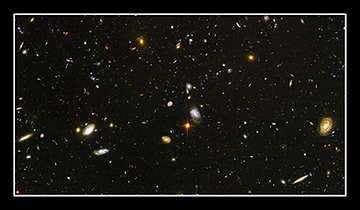Starry skies evoke awe and wonder within cosmic cathedral
COFFEE WITH WARREN, with Warren Harbeck
Cochrane Eagle, March 3, 2016

Each dot in this detail from the Hubble Ultra Deep Field image is one of the billions and billions of galaxies beyond our own Milky Way Galaxy, each containing billions and billions of stars whose light has taken millions to billions of years to reach Earth. Photo courtesy of NASA
Click for a much larger version of the image
Whenever I have a one-on-one visit with our globetrotting Cochrane coffee companion Ernest Enns, I’m left with a sense of awe and wonder. This week’s visit was no exception.
Like me, the retired professor of mathematics is a lover of light, especially as celebrated by starry skies – and the darker the skies, the better!
In fact, he had just returned from Spitsbergen, that large Norwegian island located in the arctic halfway between the mainland and the North Pole. As Ernest noted, in their 24-hour-long darkness of mid-winter, the only way you can tell whether it’s noon or midnight on Spitsbergen is by seeing whether the stores are open or closed.
Uninterrupted darkness – perfect for stargazing, right? Wrong! Unfortunately, it was cloudy the whole time he was there, so he couldn’t wait to get back to his home west of town and enjoy the delightfully dark, starry nights we often have in our Alberta foothills.
On that note, our coffee conversation turned to the awe-inspiring power of starry skies. Even to the naked eye, those few thousand faint twinkling diamonds arrayed against heavenly black velvet somehow illuminate our souls, taking our breath away and affirming the triumph of hope over despair. As Martin Luther King Jr. liked to say: “Only in the darkness can you see the stars.”
But what about the billions of billions of galactic wonders we cannot see with the naked eye? As if on cue, both Ernest and I together brought up the Hubble Deep Field.
The Hubble Deep Field (HDF) is an image taken from the Hubble Space Telescope that has been orbiting Earth since 1990. The image is the result of very long exposures of a tiny dark area of the sky near the Big Dipper taken over 10 days.
Nearly all of the spots of light in the HDF are not stars within our own Milky Way Galaxy, but galaxies of stars far beyond our own. Projected from that small patch of sky, that’s billions and billions of galaxies in the observable universe, each with billions and billions of stars whose light has taken millions to billions of years to reach us.
Now that’s awesome!
On my way home, as I reflected on Ernest’s and my cosmic coffee conversation, words from the Psalms of David came to mind: “The heavens declare the glory of God” (Psalm 19), and “When I consider thy heavens, the work of thy fingers, the moon and the stars, which thou hast ordained; what is man, that thou art mindful of him?” (Psalm 8).
Yes, such moments under dark, starry skies are indeed humbling.
So humbling, in fact, that some folks see themselves as insignificant as mere specks of dust amidst the grandeur of time and space.
To them the late Franciscan astronomer Lucian Kemble, of Mount St. Francis Retreat Centre fame, says: “Insignificant? I don’t think so. I’m as big as the things I comprehend. You and I may be made from dust, true – but it’s star dust!”
For me personally, the response to the awe and wonder I experience within this cosmic cathedral is beautifully captured in the words of Stuart Hine’s popular hymn that flows from the souls of many around our planet:
“O Lord, my God! When I in awesome wonder / Consider all the worlds Thy hands have made, / I see the stars, I hear the rolling thunder, / Thy power throughout the universe displayed. / … Then sings my soul, my Saviour God, to Thee. / How great Thou art, how great Thou art!”
© 2016 Warren Harbeck
JoinMe@coffeewithwarren.com